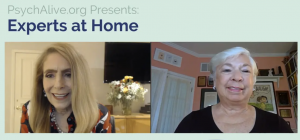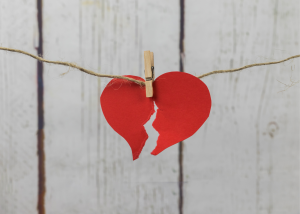Breaking the Habit of Our Unhealthy Stress Cycle
Start Making Sense of Anxiety – See, Sense, Set a New Direction
 Raise your hand if you have never experienced anxiety. I’ve asked this question to thousands of people around the country when teaching about stress reduction, and not one person has raised their hand.
Raise your hand if you have never experienced anxiety. I’ve asked this question to thousands of people around the country when teaching about stress reduction, and not one person has raised their hand.
What a relief to discover I am not the only one feeling anxious. It is part of being human. We spend a lot of energy trying to pretend otherwise. “Never let ‘em see you sweat,” a national ad campaign for antiperspirant, speaks to the sense of shame, and the fear that our perceived incompetency might lead to being “voted off the island.” So, we keep trying really hard not to be anxious.
Here, I’m talking about everyday anxiety, as natural to being human as our breath, (without excluding the many anxiety disorders that can be debilitating in everyday functioning, and need consistent attention and care; they too begin with everyday anxiety).
So what does anxiety have to do with stress?
A Word about Stress:
The word stress is thrown around about as much as the word love. “I’m so stressed out,” “I’m under a lot of stress lately,” “my kids, my job, the news. . . make me so stressed.”
To clarify, stress is healthy and needed; it is why we are here. Our ancestors survived by activating their biological system to engage in life, to fend off what was threatening, and find what was of benefit to staying alive.
Healthy stress today is when we feel that ability to be alert and motivated to move in the world, to take action, focus on a project, be responsive to environmental cues. Healthy stress is a response to the acute situations that life brings such as accidents and emergencies. Like an old friend, we can rely on this inbuilt stress reaction, a protective biological fail-safe ignition, and once the threat is gone, we return to normal.
Unhealthy stress is a system gone wrong. The ignition stays on with the pedal to the metal. It wears and tears on our biological, psychological, emotional, and relational health. We activate our brilliant biological response mechanisms meant to keep us from being eaten by lions when all that’s really chasing us is our task list. Full throttle, we stay in this activated state and burn up our energy – spending it, instead of investing in it.
People often describe stress as a sense of pressure. Think of it as pressure placed upon a platform of reserves (the body). Like supply and demand, when the reserves are low and the demand high, the price we pay will be more than we can afford.
Now, what about anxiety? It’s simply a word we have associated with a sensation (maybe the sensation of a stress reaction).
Let’s play with a thought experiment to see beyond our quick ideas about anxiety:
Experiment #1 – Try to use the word activation in the place of anxiety. What changes in your perception? What if, the next time you feel anxiety, you can say to yourself, hmm, my system is activated. Like a car engine ignition, something turned the key, and the engine turned over and began to run. Heartrate increases, breath quickens, muscles get a surge of adrenalin, eyes narrow Your whole system of body, mind, and brain orients in a certain direction.
Experiment #2 – Explore for a moment if you will, what’s the difference between the following words, and the experience these words elicit:
Anxiety
Adventure
What conjures in your mind and body as you play with each word separately?
Anxiety has a perception of trepidation and fear intermingled with imagining the worst in the future.
Adventure has a perception of excitement and encouragement to move into the future imagining something good.
If you enjoy the adventure of amusement park rides, you’ve chosen to activate your system like anxiety, but perceive it to be your choice, and therefore, are interested in approaching.
Regardless of whether the sensation being perceived is the same, it is the interpretation or translation of that experience that determines your evaluation of whether something is good or bad and whether you should approach or avoid.
At times, our ideas about anxiety can get us into trouble. Ask yourself, “what is the typical attitude I take toward anxiety?” For example:
- “I don’t like it.”
- “I don’t want it.
- “It feels awful.”
- “What if others know?”
- “What does it say about me?”
- “I better get control of myself.”
- “Get a handle.”
Now, what is a typical action you might take as a result of this attitude? What do you do to try to get away from the feeling of anxiety? Do you avoid it? How? Name a specific action taken to avoid. These habits of avoidance or relief-seeking can create more stress and perpetuate the unhealthy cycle of stress.
Think of technological portals for escape as an example of one way. Anytime we don’t feel good, we can leave and enter the “promised land” of entertainment and distraction, a muted pursuit of happiness, which actually does give us an immediate bump in the reward centers of the brain that keep us coming back for more. But this wandering only leads to more unhappiness and the need to escape, and on it goes, chasing a high that might take the edge off.
Whatever your go-to is to avoid, you can think of the ways to avoid anxiety falling somewhere on the continuum of addiction. The loose definition of addiction is “repeated behavior despite adverse consequences.” Hmm, can you see any habits you’re engaged in to seek relief that only create more stress?
Anything from Netflix to heroin, (this includes, overworking, being busy, thinking too much, focusing only on other people, gossiping, even racism and bigotry – but that’s a whole other article and discussion). To clarify, this is not moralistic; this is the human experience. We approach what feels good, avoid what doesn’t; it is our biology. So, no need for condemnation and self-improvement, big need for curiosity and care, to wake up more than our automatic biological reactions and begin to see the patterns. Then, we are conscious and discover some choice to invest in our energy. From here, we can build a responsive action. Hopefully, this article is one step in that direction.
What if anxiety was something good? What if we could train in a skill that helps us approach the sensations? We wouldn’t get caught in the cycle of unhealthy stress. Here’s how that goes:
Relief-seeking avoidance of our natural day-to-day anxiety only depletes our system, leaving us less able to meet the next demands of our life, which then only increases our stress when demands meet our lowered resource, leading to the subsequent need for increased relief, which depletes us further, and so on.
Bottom-line, relief-seeking behaviors do not restore our energy. But only you can know; it’s an internal metric that tells us. You can tell by noting whether you are more connected to your ability to engage or less connected. Are you energized or exhausted?
Let’s take a look at the unhealthy stress cycle, (see diagram).
- Awareness of event – internal or external demand
- Activation of the body’s nervous system
- Appraisal (in mind and body) of “threat”
- Action of avoidance – relief-seeking
- Depletion and more demand – the cycle escalates.

To make this your own, get specific.
First Step to Disrupt the Unhealthy Stress Cycle: See It!
- AWARE = Name the event. (who, what, where – internal or external)
- ACTIVATION = Describe the activation experience – what’s happening in your body? Heartrate, breath, jaw, shoulders, belly?
- APPRAISAL = What are you imagining is worst case? What thoughts are you having? What is the predominate emotion?
- ACTION = How do you seek relief? How do you avoid?
- AVAILABLE ENERGY = What does that do for you, immediately and the day after? Sense the relief and the later cost.
For example, it could be as simple as waking up in the morning with your task list reverberating in your head. Your heartrate increases, jaw tightens, breath shortens, and as you reach for your phone and your coffee, you can’t help imagining how you will not be able to complete those tasks, and who will be unhappy, and what the results might be. You might be thinking about how unreasonable your boss is, or that the job is just so unforgiving, or how you wonder about your own competency and skill.
You then feel anxious and already defeated, which leaves you a little irritable and defensive as you walk out your door, get in the car, fight with traffic, and reach your desk at work, where you discover a plethora of emails and more demands that have yet to be added to your task list. You are already exhausted, and it isn’t even 9am! More coffee and muster gets you hyped up and working, waiting for a break and wondering what you might do after work to find some relief. Living for the future break, “hump day,” “TGIF,” the never-ending cycle of rev up – relief – rev up – relief.
Later, you see the little box in the corner of your screen that says “the next show in the series starts in 14 seconds,” and you find yourself collapsed on your sofa, stuffing your face with too much food and a few glasses of vino, and consuming far too many episodes of entertainment. What began as comfort and relief now leaves you distracted, bored, and uninspired, as you fall in and out of sleep, dozing and defying the body’s real exhaustion, head nodding, but trying to catch that next plot theme, delaying the reality of the next day’s arrival, until one loud snore reminds you, “Oh no! I have an early meeting tomorrow and really need to get to bed.”
The next morning, you wake up groggy and more anxious with another day’s demands not waiting for your readiness to meet them. While brushing your teeth, you plan how you might find relief after work, and the cycle continues.
The way to begin to disrupt the cycle of unhealthy stress is to first add something to the system’s health. Here, we are adding our conscious care, (see it with understanding), rather than begin by trying to take away a habit. Those habits are there, because they have served a purpose. They just aren’t sustainable. Not good, not bad, just the facts from direct experience.
Second Step to Disruption: “Start Making Sense” (see diagram)
Now that you see the cycle, next sense it!
This is not easy, but like anything we learn, it takes some repetition to build the skill. Here, you have to begin to approach what you have been avoiding. The secret is to know it all makes sense; there’s nothing wrong with you, and this skill becomes a super power and gives you back your energy. Remember, the sensation of anxiety can feel like the monster in our dreams. Here, we are deciding to have tea with the monster. What helps us do this is open curiosity and interest to get familiar with this experience that has captured our attention far too long.
It helps to understand from a less personal point of view.
All day long, our body is receiving perceptual cues. This is not even something we know consciously. Think of the body as a sack of sensors, trying to navigate all the incoming information, and make sense of it all, deciding what’s relevant, what to let in, what not to, what the meaning of that information is.
Keep in mind, our brain likes to simplify things to save energy. It will remember where certain information came in, how the body reacted, and what you interrupted from that sensation. That way you don’t have to think about it; your action will happen automatically.
However, now we have linked other things together that may lead to chronic stress. Maybe you know what it’s like to wake up, wonder, and worry what will come. Maybe this sequence has been repeated enough times that just waking up can equal an automatic stress reaction.
So, let’s make sense of this looping habit with the common example of public speaking. For many people, public speaking equals anxiety and is even feared more than death. What is that “sack of sensors” detecting? What is that perceptual cue? If you’re standing in front of other people, it may activate your system to take some type of action. For example, it offers some norepinephrine (stress hormone) to engage your alertness to the situation. Your interpretation of the sensation of that hormone might create a meaning of threat. The mind might decide those people are evaluating me. “Oh no! What if they don’t like me? What if I get voted off the island?”
Interpreting speaking in front of others as a threat is something we is learn by repeatedly sensing the body’s natural activation as alarm, just as waking in the morning brings the immediate assumption of anxiety. There is some evolutionary biology we can understand to help appreciate our predicament, as we are social beings in need of true affiliation to survive. The thought of “what if they don’t like me?” can raise the threat level to a sense of survival, not just an issue of thumbs up or down. But we can guide our old biology!
Now, what if we decided to sense what is happening in the present versus the past, which created that automatic filter that speaking is bad? We can create a new memory by being with sensation in the present with new meaning.
The OLD memory translated the perceptual cue (speaking in public) and the body’s activation (heart beating faster) as the interpretation of danger. This leads to contraction and avoidance.
The NEW memory of public speaking may translate sensations, such as the faster heart beat, as helping me be more alert. This can be exciting like an adventure/challenge/opportunity. This leads to expansion and approach.

Here is Step 2 – Disrupt the Unhealthy Stress Cycle: Sense It!
- AWARE = Name the event (who, what, where – internal/external)
- ACTIVATION = Sensing the body in the present, direct experience versus old memory determining
- APPRAISAL = Reinforming sensation of activation – from threat to challenge
- ACTION = Approach – Attend with interest
- ENERGY = Restore versus relief = Resourced
Begin Again #1 Next Day/Event = Responsive and able. Building new habit of healthy stress.
Embodied Process:
This is not just another cognitive strategy, but an embodied process. Sensing the direct experience and reminding the body that this is just a sensation breaks up the automatic conclusion that what’s happening is bad.
Imagine the energy saving possibility in this. The engine can run smoothly, accelerating when needed, braking when needed, turning off instead of burning unnecessary fuel. When the day comes to an end, you may no longer need those habits of avoidance in a search of relief. Instead, you may be ready to engage in a restorative activity from the surplus of sustainable energy found in making sense all day long of this thing called anxiety.
Third Step to Disruption of Unhealthy Stress Cycle
Set a New Direction
Creating a new memory by becoming a conscious translator of bodily sensation can help you to no longer let the past impede on the present and determine the future. Give yourself permission to raise your hand, to “let ‘em see you sweat,” as you see, sense, and set a new direction for yourself.
© 2018 All Rights Reserved, Your Gateway to Healing™, Diane Renz, LPC, 720 317 5170








